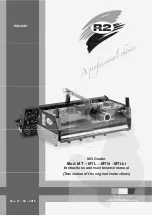
18
Excessive power not pulled. Slowly advance input power (Don’t allow +15 supply to go
higher than 16V). If power pulled is greater that 20W, before reaching 120VAC in, refer
to “Excessive Line Power Test”.
As you ramp out the input voltage, verify that +15V supply stays in regulation. If supply is
non-existent or excessive refer to “+/– 15V Supply Test”. Verify –15V supply is proper, if
not, refer to above test.
Check –V1 (–39V) and +V1 (39V). If non-existent refer to “+/– 39V Supply Test”.
Check –V2 (–77V) and +V2 (39V). If low refer to “+/– 77V Supply Test”.
Verify that “Mute” test point is close to –15V. Remove power to unit and verify mute line
immediately (200mS) goes high (+15). Re-power board and verify mute line initially goes
high and then goes low about 2 seconds later. If any of the above is not true refer to “Ampli-
fier Muting Test”.
C) Confirmation of Low Frequency Chain:
Measure across emitters of Q1 and Q13, for 4mVDC +/– 300uV (20mA). If required adjust
bias pot, VR1. Measure at low frequency amp output (+LF test point) and confirm less than
+/– 50mV of offset. Turn on Generator A and adjust frequency to 400Hz. Adjust Oscillator
amplitude to obtain 60V P/P at amp output. The waveform should be a nice clean sine
wave, with perhaps, a small hint of clipping. The amp will begin to clip at around 62V P/P.
If the amp prematurely clips, verify input to the amp is not clipped. The amp input can be
measured at the junction of R22 and C18. With 60V P/P at the amp output there should be
around 1.9V p/P at the input to the amp. If one or more of the above tests fails. proceed to
“Low Frequency Power Amp Test”.
Adjust oscillator for 1.9V p/P at pin 1 of U2. Verify voltage at input to the filter, pin 1 of J3,
is about 3.5V P/P. If not, proceed to “Low Frequency Filter Test”.
D) Confirmation of High Frequency Chain:
Turn off Generator A. Adjust “High Frequency Level” control, VR201, on signal board, fully
clockwise. Measure at high frequency amp output (+HF test point) and confirm less than
+/– 50mV of offset. Turn on Generator A and adjust frequency to 3kHz. Adjust Oscillator
amplitude to obtain 60V P/P at amp output. The waveform should be a nice clean sine
wave, with perhaps, a small hint of clipping. The amp will begin to clip at around 63V P/P.
Adjust “High Frequency Level” fully counter clockwise and verify that output level reduces
to around 35V P/P (5dB). Re-adjust “High Frequency Level” fully clockwise. If the amp
prematurely clips, verify input to amp is not clipped. The amp input can be measured at the
junction of R50, R51 and R39. With 60V P/P at the amp output there should be around
2.8V P/P at the input to the amp. If one or more of the above tests fails proceed to “High
Frequency Power Amp Test”.
Adjust oscillator for 3.2V P/P at pin 7 of U2. Verify voltage at the input to the filter, pin 1 of
J3, is about 4V P/P. If not, proceed to “High Frequency Filter Test”.
Summary of Contents for EON15
Page 23: ...High Frequency Response EON Power15 and EON15P 1 230 33...
Page 24: ...Low Frequency Response EON Power15 and EON15P 1 230 34...
Page 30: ...Low Frequency Response EON PowerSub 40...
Page 35: ...High Frequency Response EON Power10 45...









































